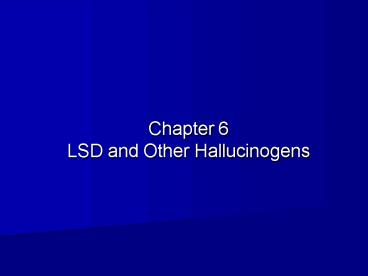LSD and Other Hallucinogens - PowerPoint PPT Presentation
1 / 19
Title:
LSD and Other Hallucinogens
Description:
Atropa belladonna (atropine), mandrake, henbane, datura stramonium (jimsonweed) ... Four combinations: Atropa belladonna, mandrake, henbane, and various species of ... – PowerPoint PPT presentation
Number of Views:589
Avg rating:3.0/5.0
Title: LSD and Other Hallucinogens
1
- Chapter 6
- LSD and Other Hallucinogens
2
(No Transcript)
3
MAJOR CATEGORIES OF HALLUCINOGENS
- Hallucinogens related to serotonin
- LSD, psilocybin,, DMT, harmine
- Hallucinogens related to norepinephrine
- mescaline, DOM, MDMA, MDA
- Hallucinogens related to acetylcholine
- atropine, scopolamine, hyoscyamine, ibotenic
acid - Miscellaneous hallucinogens
- PCP, ketamine
4
HIGHLIGHTS FROM THE HISTORY OF LSD
- 1938 --- Albert Hofmann synthesizes LSD-25
first tested in 1943 - 1953 --- Sandoz Pharmaceuticals applies for FDA
approval of LSD - 1961 --- Timothy Leary and others at Harvard
begin experimental LSD sessions - 1960s --- Psychedelic era
- 1966 --- LSD made illegal in the U.S.
- 1990s --- LSD re-emerges as a club drug
5
HISTORY OF TIMOTHY LEARY
- Pre-1960 --- Leary is on faculty of Harvard
University - 1960 --- Has first hallucinatory experience, with
psilocybin - 1961 --- First experiments with LSD
- 1963 --- Leary dismissed from Harvard
- 1968 --- Media calls him the high priest of LSD
- 1970 --- Leary arrested for marijuana
possession, escaped, cleared on appeal - late 1980s --- Leary discovers computers
- 1996 --- Leary dies body rocketed into space
6
POSSIBLE ACUTE EFFECTS OF LSD
- Excitation of sympathetic autonomic activity
- Laughing or crying, depending on the expectations
and setting - Images seen with the eyes closed
- Intermingling of senses (synesthesia)
- Percpetion of a multilevel reality
- Exaggerated configurations of common objects
- Mood swings
- A feeling of timelessness
- Separation of ones mind from ones body (ego
disintegration)
7
LSD EFFECTS ON THE BRAIN
- LSD closely resembles the molecular structure of
serotonin - LSD stimulates a special subtype of
serotonin-sensitive receptors - All hallucinogens stimulate these receptor sites,
even those whose molecular structure does not
resemble serotonin
8
LSD EFFECTS ON THE BRAIN
- http//thebrain.mcgill.ca/flash/i/i_03/i_03_m/i_03
_m_par/i_03_m_par_ecstasy.htmldrogues
9
PATTERNS OF LSD USE
- From 1967 to 1971, lifetime prevalence rates
among high school seniors rise from 1 percent to
18 percent. - In 1986, lifetime prevalence declined to 7
percent. - In 2005, lifetime prevalence was less than 4
percent.
10
QUESTIONS ABOUT LSD EFFECTS
- Will LSD produce a dependence?
- Will LSD produce a panic or a psychosis?
- Will LSD increase creativity?
- Will LSD damage chromosomes?
- Will LSD have residual (flashback) effects?
- Will LSD increase criminal or violent behavior?
11
EMERGENCY GUIDELINES FOR A BAD TRIP ON LSD
- Stay calm.
- Reassure the individual that the situation is
temporary. - Reduce loud noises or bright lights.
- Allow the individual to move around without undue
restrictions. - If unsuccessful in producing a reduction in the
panic, seek medical attention.
12
NON-LSD SEROTONIN-RELATED HALLUCINOGENS
- Psilocybin (shrooms) --- less potent than LSD,
shorter trip than with LSD, hallucinations more
strongly visual, less emotionally intense and
more euphoric than those of LSD - DMT --- much briefer acute effects
- Harmine --- trance effects, dream-like
hallucinations
13
NOREPINEPHRINE-RELATED HALLUCINOGENS
- Mescaline --- similar effects as that of LSD,
though hallucinations may be more sensual and
there are fewer mood changes - DOM --- much more potent than mescaline but far
weaker than LSD, far higher incidence of a bad
trip than with LSD - MDMA (Ecstasy) --- carries the reputation of
having the stimulant properties of amphetamines
and the hallucinogenic qualities of mescaline
14
POSSIBLE ADVERSE EFFECTS OF MDMA (ECSTASY)
- Hyperthermia and heatstroke
- Dehydration and electrolyte depletion
- Irregular heartbeat
- Kidney and liver failure
- Long-term neurochemical changes
- Agitation and confusion
- Depression and anxiety
- Long-term memory impairments
15
ACETYLCHOLINE-RELATED HALLUCINOGENS
- Amanita muscaria mushrooms (fly agaric)
- muscle twitching, hallucinations, dizziness,
aggressive behavior - Atropa belladonna (atropine), mandrake, henbane,
datura stramonium (jimsonweed) - general sympathetic effects, bizarre
hallucinations, disorientation
16
HEXING DRUGS AND WITCHCRAFT
- Hexing drugs generally involve drugs that block
the parasympathetic effects of acetylcholine. - Anticholinergic drugs include atropine,
scopolamine (also called hyoscine) and
hyoscyamine. - Four combinations Atropa belladonna, mandrake,
henbane, and various species of the datura plant
17
HISTORY OF PCP
- Introduced in 1963 as a surgical anesthetic
- Withdrawn in 1965 because of adverse patient
responses - Used as an animal anesthetic up to the late 1970s
- Classified as a Schedule I drug in 1979
18
ACUTE EFFECTS OF PCP AND KETAMINE
- Manic excitement
- Depression and anxiety
- Sudden mood changes
- Disordered and confused thought
- Paranoia
- Unpredictable aggression
- Depersonalization (detachment from people)
19
(No Transcript)































